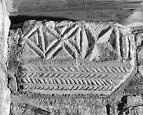Select a site alphabetically from the choices shown in the box below. Alternatively, browse sculptural examples using the Forward/Back buttons.
Chapters for this volume, along with copies of original in-text images, are available here.
Object type: Two chamfered imposts or friezes
Measurements:
a (east): H. 18 cm (7 in); W. 28.5 cm (11.25 in) D. (to wall) 6.4 cm (2.5 in)
b (west): H. (max.) 18 cm (7.5 in); W. 25.5 cm (10 in) D. (to wall) 5.7 cm (2.25 in)
Stone type: Medium-grained, massive yellow sandstone
Plate numbers in printed volume: Pl. 234.1328-1330
Corpus volume reference: Vol 1 p. 238
(There may be more views or larger images available for this item. Click on the thumbnail image to view.)
a. A (long): The flat upper panel is divided from the lower chamfered panel by a roll moulding. The upper contains one and one half registers of saltire ornament, in which on the left the relief saltires are formed by grooving the outline. On the right a different type of saltire is formed by cutting away the background. The design is finished on the right by a broad flat-band moulding. Below, four kinds of alternate facing cable mouldings are enclosed at the top and bottom by a flat-band moulding. The double cable at the centre is so cut that it resembles a `wheat-ear' design. B (narrow): A rectangular panel at the top and a triangular panel below survive. The upper panel contains a saltire cross in relief with the ground behind deeply recessed. Below, the cable patterns have been cleverly converted to a zig-zag. C and D: Built in.
b. Part of the same or a paired architectural fragment. A (long): The flat upper panel is divided by a plain roll moulding from the lower chamfered face. The upper panel is enclosed at the left by a broad flat-band moulding and contains two panels with saltire ornament, the left with the saltire formed by grooving out the relief outline, the right by cutting along the background. Below are four rows of alternate facing cable mouldings and part of a plain flat-band moulding below them. B and C: Built in. D (narrow): Broken off.
Appendix A item (stones dating from Saxo-Norman overlap period or of uncertain date).
These saltire patterns are also found in an incised form on Bolam 2 and Unknown Provenance 5, and in a relief form on the relieving arch round the blocked west door of Corbridge church (see also the finial cross, Corbridge 5).



